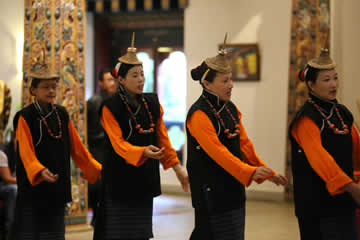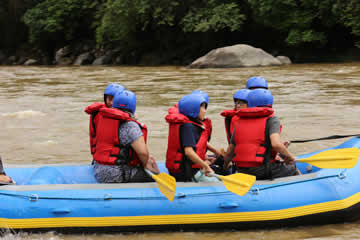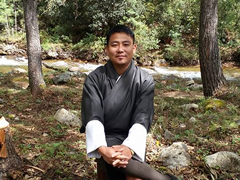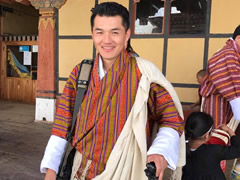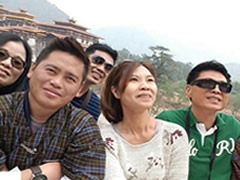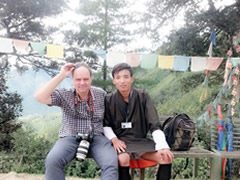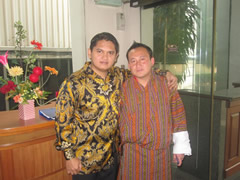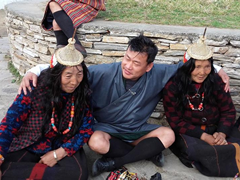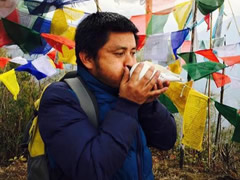16 nights 17 days Gomphu Kora Festival
When is Gomphu Kora festival ? Gomphu Kora Festival starts from 31cMarch, 2023 and ends on 02nd of April, 2023.
Gomphu Kora is situated 23 kilometres from Trashigang Dzong. Gomphu translates to meditation cave and Kora translates to circumambulation. The festival was first initiated by the 4th Desi Tenzin Rabgye in the 16th century. The monastery which stand today in Gomphukora was later built in the 9th century by Ani Choten Zangmo, a reincarnation of one Peling lama.
Tour Highlights
- Witness sacred dances and rituals performed by Monks and local people of Trashigang and Trashi Yangtse with colourful costumes.
- Interact with the people of Arunachal Pradesh
- Join in with locals in a special occasion of celebration, blessings and socializing.
- Explore Phobjikha Valley, winter home to the Black-Necked Crane.
- Visit many cultural attractions including medieval fortresses (Dzongs), markets and museums.
- Hike up to the famous Taktsang Monastery, as we believe that visiting one time Tiger nest is equivalent to visiting 1000 temples.
- Marvel at the elaborate and ancient wall paintings and carvings in Dzongs and temples.
- Finding Happiness in Action Bhutan tours with Varieties of Bhutanese games and sports.
- Visit one of the farm house and have hot stone bath.
- Meet with one of the great master to listen the teaching of Buddhism.
- Leisure walk in Town to have souvenirs and etc
Detailed Itineraries
16 night 17 days Gomphu festival Tours
|
Day 1 |
Guwahati – Samdrup Jongkhar Our representatives of Zoid Jin Tours and our counterpart from Assam, India will be going to receive from Guwahati international air port and you will be make a drive of about 2 hours to reach Samdrup Jongkhar and after immigration formalities you will be check in to hotel for lunch / refreshment. Samdrup Jongkhar also known as the gateway to eastern Bhutan holds the distinct honor of being the oldest town in Bhutan. |
|
Day 2 |
Samdrup Jongkhar – Trashigang Today’s drive is a 6-7 hour drive from the the tropical foothills of the Himalayas to temperate Himalayas. You will notice the sharp change in vegetation and climate. The drive is supposed to be one of the most beautiful drives with scenic landscape and it is a well known for sighting different species of exotic birds. You will come across Dewathang village which is a historical site as the Father of the First king Ugyen Wangchuk led the Bhutanese troops to battle with the British and finally signed the “Sinchula treaty” with the British in 1865 on a peace note. |
|
Day 3 |
Day excursion to Trashiyangtse Right after your breakfast you will go to visit the famous Chorten Kora which was built in 1740; it starkly resembles the Bodhisattva temple of Nepal. The temple has beside it a black rock which has the imprint of Guru Padmasambhava’s thumb print, hat and his body, which is a sight you must visit. Pilgrims from all corners of Bhutan and from the Indian state of Arnachula Pradesh come to attend the famous annual Tsechu/festival where everyone circumambulate the Chorten all night long. In the evening drive to Trashigang, the biggest district in Bhutan. |
|
Day 4 |
Gomphu Kora Festival Gomphu translates to meditation cave and Kora translates to circumambulation. The festival was first initiated by the 4th Desi Tenzin Rabgye in the 16th century. The monastery which stand today in Gomphukora was later built in the 9th century by Ani Choten Zangmo, a reincarnation of one Peling lama. You will be enjoying the whole day interacting with the people of Trashigang, Trashiyangtse and also with the people of Arunachal Pradesh. You will have a hot picnic packed lunch. After the festival drive back to Trashigang for overnight stay. |
|
Day 5 |
Trashigang Sightseeing – Mongar After breakfast visit: Trashigang Dzong: The Fortress of the Auspicious Hill' was built in 1659, to defend against Tibetan invasions. This imposing fortress is strategically situated high atop a spur overlooking the Dangmechu River. Then travel to Mongar through Korela pass. |
|
Day 6 |
Mongar- Lhuentse Excursion Today day excursion to Lhuentse, it is one of the most isolated districts in Bhutan. The landscape is spectacular, with stark cliffs towering above river gorges and dense coniferous forests. The region is famous for its weavers, and their distinctive textiles are generally considered to be the best in the country. The Kurtoe region of Lhuentse is the ancestral home of the monarchy. We will also visit Takila to see the tallest statue of Guru Nangsey Zilneon. The 157 feet Guru Nangsey Zilneon statue is the one of the tallest statue in the world. Seated on a 38 feet lotus located on a hill in Takila overlooking Tangmachu village in Menbi gewog, the construction took more than seven years. Located on a 27-acre area in Tangmachu, besides being a pilgrimage site, the site would also serve as a place where people can come for meditation and retreat. You can also visit Kushitara Weaving Centres in Lhentse and if you want to buy souvernirs then these the cheapest place. In the evening return back to Mongar. overnight at a hotel in Mongar
|
|
Day 7 |
Mongar- Bumthang Today you will be driving to central part of Bhutan-Bumthang. Places from hereon are very rural and you will notice the glaring difference between the Western and Eastern Bhutan. It is about 7 hours drive from Mongar to Bumthang through high mountain passes and rural villages. You will be driving thru Serthang La pass which is about 3506m and then descend down to Ura village. Ura is a clustered settlement and you can walk through the village and visit the main temple. The drive from Ura leads up to Thrumshing La Pass at 3,780 meters – the second highest driving point in Bhutan (the first being the Chelela Pass in Paro). Continue drive through Sengor village, Namling ridge, Yonkola, Thridangbi villages till you reach the warm village of Lingmithang. Located by the riverside Lingmithang is very warm so you can take a breather in the hot air after your cold drive till then. Overnight at Bumthang |
|
Day 8 |
Bumthang Sightseeing After breakfast, visit the following: Jambay Lhakhang, built in the 7th century by the King Songtsen Goempo of Tibet. In his effort to propagate Buddhism he had a plan to build a total of 108 temples in Tibet and neighboring kingdoms. Kujey Lhakhang (Kujey means, "Body imprint"). The temple to the right is the oldest and was built by Minjur Tempa in 1652. It was built around the cave in which Guru Rimpoche meditated and left his body imprint. Tamshing Lhakhang: This temple is also known as Tamshing Lhendrup Chholing (Temple of the Good Message). In the evening stroll around the beautiful landscape of the Bumthang Jakar valley After lunch drive to Mebar Tsho (Burning lake) and visit the lake and then drive back to your hotel and in the evening you may wish to stroll around the beautiful landscaped gardens of Bumthang. In the evening you may wish to stroll around the beautiful landscaped gardens of Bumthang. Dinner & overnight at a hotel in Bumthang. Overnight at Bumthang
|
|
Day 9 |
Bumthang- Trongsa After breakfast visit Trongsa Dzong and after lunch at Trongsa visit: National Museum which is housed in the Ta Dzong (watch tower).A museum in which aspects of Bhutanese culture and history are explained by beautifully objects. Documentary will be shown too which explains a great deal about Bhutanese history and history of monarchy. Trongsa Dzong: Trongsa Dzong is the largest dzong fortress in Bhutan, located in Trongsa (formerly Tongsa) in Trongsa district, in the centre of the country. Built on a spur overlooking the gorge of the Mangde River, a temple was first established at the location in 1543 by the Drukpa lama, Ngagi Wangchuk son of Ngawang Chhojey. |
|
Day 10 |
Trongsa – Phobjikha Valley After Breakfast our representatives from Zoid Jin Tours will led you the beautiful Phobjikha Vally via the Pelela Pass at 3420 meters. Gangtey, Phobjika and the surrounding villages are located in one of the most beautiful glacial valleys of Bhutan and a favorite with tourists. The valleys are also home to the endangered and graceful Black Necked Cranes in the winter and you can see them in the marshes in the middle of the valley. In the summer the cranes fly to Tibet. Visit the Gangtey Monastery located atop a hill overlooking the valley. Gangtey Gonpa is an important Monastery of the Nyingmapa school of Buddhism. |
|
Day 11 |
Phobjikha – Punakha After breakfast you will be walk round the phobjikha valley and then will make a drive to Punakha. After lunch visit: Punakha Dzong: Punakha valley was the old capital city of Bhutan and the Punakha Dzong meaning the fortress of Great Bliss, was built by in 1673 by Zhabdrung Ngawang Namgyel (the first spiritual & political leader of Bhutan) to commemorate the final victory against numerous Tibetan invasions. Located on a piece of land between two rivers Pho Chhu and Mo Chhu (literally meaning male and female rivers), the Dzong is massive, huge and magnificent in all its architectural grandeur. Although ravaged by flood, fire and earthquakes many times, the Dzong was always rebuilt with its original pattern and design. Chhimi Lhakhang, famously known for its fertility shrine, where one can receive a special fertility blessing. |
|
Day 12 |
Punakha Sightseeing – Thimphu (the capital of Bhutan) After breakfast drive through upper Punakha valley passing through farm houses and take a short hike through farmhouses to the beautiful Khamsum Yuelley Namgyal Lhakhang (temple built by the Queen Mother of Bhutan for peace and stability in this ever-changing world. This temple is situated on the hilltop overlooking the valley below. The leisurely walk up to the temple would take about 1 hour. Visit the temple and also enjoy the breathtaking view from there. Water Rafting: If interested while coming back down from Khamsum Yuelley Namgyal Lhakhang there is a water rafting facilities and if you wanted to have this service our representatives will arrange for you else you will be drive back to Punakha. After Lunch: Drive towards Thimphu enroute through Dochula Pass (3,088m/10,130ft). In the clear sky; enjoy the panoramic view of the Himalayan mountain ranges. Then pass by the beautiful 108 chortens built on the hill by Her Majesty Ashi Dorji Wangmo (Queen Mother of Bhutan) for the security and well being of His Majesty, the King of Bhutan. And also visit Druk Wangyal Lhakhang (temple) .The temple was built to honor His Majesty the fourth Druk Gyalpo, Jigme Singye Wangchuck. The past and future appear to merge in the details of the lhakhang that tells the story of a supreme warrior figure whose vision pierces the distant future. Overnight at Thimphu |
|
Day 13 |
Thimphu Sightseeing
After breakfast visit: · Kuenselphodrang ( commonly known as Buddha Point) where the largest Buddha statue in the country is perched on the hillock overlooking the Thimphu Valley. You may take a nature hike through Kuenselphodran Nature Park for about 20-30 minutes.· · The National Memorial Chorten (stupa) which was constructed in 1974 as a memorial for the third King of Bhutan, King Jigme Dorji Wangchuck, who is widely regarded as the father of modern Bhutan. The term ‘chorten’ literally means ' seat of faith' and Buddhists often call such monuments the 'Mind of Buddha'. Meet the elderly generation in circumambulation, especially in the evenings, at the National Memorial Chorten. · · Craft Bazaar – A one stop place to witness Bhutanese culture and buy Bhutan made art and craft product. The Bazaar in its 80 stalls covers all aspects of the traditional arts and crafts of Bhutan.At this Bazaar craftsmen and artisans from across the country display and sell their handicrafts. And also visit other handicraft stores. · Changangkha Lhakhang (temple): Changangkha Lhakhang is an old fortress like temple and monastic school perched on a ridge above Thimphu. It was established in the 12th century on a site chosen by Lama Phajo Drukgom Shigpo, who came from Ralung in Tibet. The central statue is Chenresig in an 11-headed, thousand-armed manifestation ( God of compassion). There are enormous prayer wheels to spin and even the prayer books in the temple are larger in size than usual Tibetan texts. · Sit for awhile and will have meditation along with the Guidance. Circumbulate the temple and your daughter will enjoy the best Changangkha temple architecture. · Takin Preserve, which houses the national animal the Takin that is only found in Bhutan. This is an extremely rare member of the goat family. Found in herds in the very high altitudes (13,125ft and over). They live on a diet of grass and bamboo. It can weigh as much as 550 pounds. · After Lunch Visit: Nunnery (Thangtong Dewachen Nunnery) The nunnery, popularly known as Zilukha Anim Dratshang is located above Zilukha Lower Secondary School, overlooking Tashichodzong in Thimphu valley. It is a few minutes’ drive from the main Thimphu town. King’s palace: From Nunnery temple enjoy the view of King’s Palace, Parliamentary house, Courts and the best design of Nunnery. · Tashichhoe Dzong, a fortress of the glorious religion. It was built in 1641 by Zhabdrung Ngawang Namgyel and was reconstructed into present structure by the late King, His majesty Jigme Dorji Wangchuck in the year 1962-1969. It houses the secretariat building, the throne room and the office of the king, and the central monk body. · Over night at Thimphu
|
|
Day 14 |
Thimphu- Haa Home Stay After breakfast you will drive from Chuzom by making left hand drive to Haa valley where you will enjoy the three mountains of Haa valley. Visit: White and black temple. Overnight at one of the home stay at Haa Valley |
|
Day 15 |
Haa- Chelela Pass – Paro Sightseeing Chelela Pass separates Haa and Paro Valley and at 3810 m. It is one of the highest motor able pass in Bhutan. The drive till here either from Paro or Haa is through dense spruce and larch forests according to the seasons. On a clear day, there are spectacular views of Mt. Jumolhari, Jichu Drake and adjoining peaks to the nort west as well as the view of Haa and Paro Valley. After Lunch Visit: Ta Dzong, built in the 17th century as a watchtower for the Paro Dzong. This dzong was converted into the National museum in 1968 and is filled with antique thankha paintings, textiles, weapons and armor. Rinpung Dzong, built in 1646 to defend the valley against Tibetan invaders. The Dzong is now being used as an administration center and school for monks.Then walk down to Rimpung Bridge (Traditonal Bridge), oldest bridge in Bhutan. In the evening stroll through Paro town and you may visit local shops.
|
|
Day 16 |
Paro - A Hike to Paro Takshang ( Tiger nest Temple ) After breakfast, hike up to Taktsang Monastery, also known as ‘Tiger’s Nest’. The climb up to the viewpoint will take around 1 ½ hours and from there you will enjoy a spectacular view of the monastery clinging to the side of the cliff. Stop for refreshment at the View Point Cafeteria.Then walk further up to the monastery which will take another 1 ½ hour. It is said that in the 8th century Guru Rinpoche flew on the back of a tigress from eastern Bhutan to this place and meditated in a cave here for 3 months. The principal Lhakhang (monastery) of the present monastic complex dates from 1692. Taktsang was damaged severely by fire in 1998 but has now been fully restored to its former glory.After visiting the monastery, walk back down to the road on the way stop for lunch at the view point cafeteria and then walk further down to the road point. Then travel back to your hotel, on the way visiting Kyichu temple,one of the 108 temples built in the 7th century by the Tibetan King Songsten Gampo. The story goes that a giant demon lay across the whole area of Tibet and the Himalayas and was preventing the spread of Buddhism. To overcome her, King Songtsen Gampo decided to build 108 temples, which would be placed on all the points of her body. Kyichu Temple is one of the 108 temples. In the evening you will visit one of the farm house and at the same time if interested zoid jin tours will be organizing Cultural programs and dinner with the Managing Director of Zoid Jin Tours. Dinner and overnight at a hotel in Paro. |
|
Day 17 |
Paro- onward Destinations Zoid Jin Tours & Treks (your local Bhutan travel agent) will see you off at the Paro Airport for your onward destinations. |
Gomphu Kora Festival Tour Cost
| Tour Cost for 1 person | $3,928( USD Three thousand nine hundred and twenty eight only) | Includes single person surcharge of $40 per night |
| Tour Cost for 2 people | $3,368 (USD three thousand three hundred and sixty eight only) | Includes two people surcharges of $30 per night |
| Tour Cost for 3 people & above | $2,938 (USD two thousand nine hundred and thirty eight only ) | No surcharges is applicable for 3 people and above. |
The above Bhutan tour cost includes:
- Bhutan Government Royalty of US$65 per night per person
- Twin sharing hotel Rooms at 3 star hotels
- All Meals at 3 star hotels
- English speaking tour guides
- All transportation's within Bhutan
- All entrance fees to museums and monuments
- All internal taxes and charges
- Fresh drinking Mineral water
- Extra Guide's while Hiking
The above Bhutan tour cost doesn’t includes:
- Visa fee US $40 each
- Airfares (optional)
- Travel insurance (recommended but not available in Bhutan)
- Other personal expenses, calls overseas and other more
- Guide and driver tipping's


